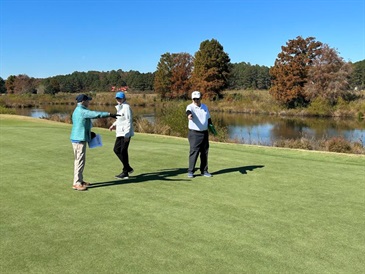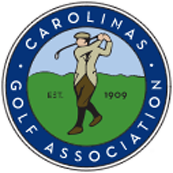CGA's 100-Plus Volunteers Help Rate Courses

A squad of a handful of veteran volunteers took to Woodlake Country Club on a chilly morning representing the Carolinas Golf Association to complete an integral part of the renovated course’s reopening process.
There was no manual labor work done, nor did the group have golf clubs in their hands — that part was for the next day — but their job was to quantify the toughness of all 18 holes, from every tee to every green. The half day’s work from the large number helps with every aspect of handicapping from the golf course after the course rating process is completed.
“We’ve got to go out from each different tee, we’ve got black, blue, white and red, and see where the scratch golfer would hit it to, that many yards away. See where the bogey golfer hits it to, that many yards away,” said Greg Kelly, the CGA’s director of course rating and membership. “We’re basically working our way down the fairway in about 40- to 50-yard increments.”
Candie Robertson checks a greenside bunker depth at Woodlake Country Club during a recent course rating visit.
Kelly has been working with the association handling course rating for nine years. The Carolinas Golf Association is like the other statewide and regional golf associations that complete the course ratings for data included in the U.S. Golf Association’s handicapping services, which is included in the World Handicap System.
New changes coming into effect this year to the World Handicap System will require short courses, including par-3 courses, to have a course rating completed to provide handicapping services for golfers at those specific courses.
This adds on to an already busy schedule that Kelly has, but he is thankful for a network of 100-plus course rating volunteers to help him from the coast to the mountains in North Carolina.
“The USGA requires that we re-rate courses every 10 years. I’ve got about 450 courses in North Carolina that I’m responsible for, so that puts me at about 45 to 50 years, and then if there’s any major renovations like they had here, that goes on too,” Kelly said. “The CGA and our team do about 50 to 55 a year. We’ve got eight different teams in North Carolina, and this is the local team for all the Sandhills area courses.”
Course rating goes further than just counting the bunkers and ranking holes one through 18 without any bias or preconception about the holes based on appearance.
From the tee, the raters base distances off the tee for the scratch golfers average distance, and the average bogey golfer distance. Factors such as the roll determined by the pitch of the fairway, elevation from the tee, any doglegs or forced carries on the hole, the elevation into the green, the green target and rough are taken into account.
“Each place we stop, we’re going to do things like, get a fairway width, distance to a lateral hazard. These are all different things that are looked at in a rating,” Kelly said. “Pretty much, anything that would make the course more difficult is being looked at.”
Course rating volunteers Sandy Burger, left, Dean Kalles and Candie Robertson measure the distance into the 18th green at Woodlake Country Club during a recent course rating visit.
These selections are then quantified using what Kelly calls the “Bible” for course rating — the USGA Course Rating System Guide.
“We’re making notes on all of these,” Kelly said. “Each of the different obstacles, you’ll get a measurement. By the time we get all of this filled out for all 18 holes, we punch it into the USGA software, and then the magic happens. You have a course and slope rating.”
Kelly keeps tabs on each re-rating with each course that goes around a decade between visits to make sure there are no substantial differences from one rating to the next.
“I will compare the new ratings to the old ratings, and if there’s a big difference, that throws a red flag for me. On a single set of tees, the black tees for every single hole, there are a little under 500 data points you’ll have. I’m not going to go and dig into all 500 of them, but the software I use from the USGA has a course rating variance report. I can print that out, and it will say if the topography values are a lot higher than they used to and vice versa,” Kelly said. “It’ll pinpoint for me what changes there are, and I’ll go in and take a look at it.”
Course raters come back the following day, not only as a nice perk of volunteering, but also to make sure their measurements are true.
“It also gives them a chance to elevate their numbers. We’ll be evaluating a green, for instance, and you have to determine how much undulation or slope you feel is in it. Well, you go out there and think it’s relatively flat, but you come back the next day and you hit that downhill putt from 15 feet and it rolls 20 feet by, and you’ll think, ‘Yeah, I’m going to grade that a little higher,’” Kelly said.
From thousands of data points, rangefinder readings and a number of volunteer hours, the typically overlooked course and slope rating of a golf course on each scorecard is tabulated to help keep golf’s handicapping system going for a fair game between skill levels.
By Jonathan Bym / The Pilot (910) 693-2470 or jonathan@thepilot.com
Please find the original article from The Pilot here (Note: subscription required)
